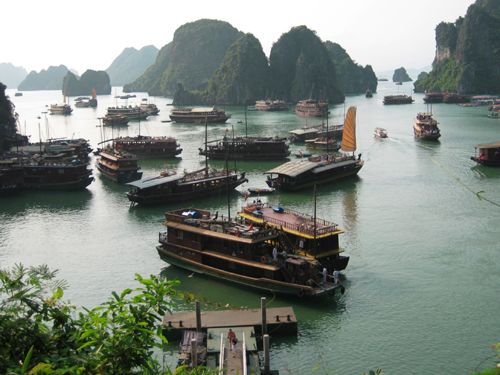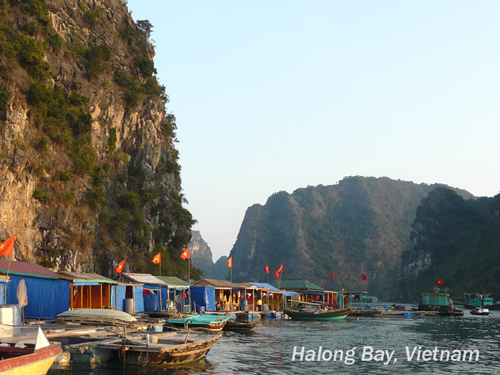I hunkered in the doorway of an office building as gray clouds moved in, threatening to break open above me. Piles of luggage were stacked in the doorway, but I held tightly to my backpack. As a solo traveler making my way through Vietnam, I had yet to let someone else touch my bag, the essence of my livelihood halfway around the world.
Earlier that morning I had taken a hired car from Hanoi to the coast of Vietnam. This part of the country, known as Halong Bay, was rumored to be tacky and touristy, so I opted instead to head straight for the water.
In fact, most travelers come to Halong Bay for one thing: To tour the bay by junk. These pirate-looking ships generally hold anywhere from a single couple to several dozen people, depending on the boat and tour operator.
Of the nearly 2,000 islands in Halong Bay, only about 300 of them have names. These sheer-faced rocks, covered with luscious trees and foliage, rise out of nowhere in the sea. Apparently birds, snakes, and monkeys live on them, but I can’t imagine that much else does.
As the junk floated among the islands, I sat on the top deck; my legs dangling over the edge of the boat, watching the world recede behind us. The warm, humid air sat heavy on my shoulders, and the dark green of the islands reflected onto the rough surface of the water despite the overcast sky. I felt like we were cruising through a waterlogged version of Jurassic Park.
We piled into the day cruiser that was pulled alongside the junket. One of the boat hands steered the craft toward Công Ðâm. The village “chief” greeted us, poured lukewarm tea into a set of chipped mugs and answered our questions about his home. This, the second largest fishing village in the bay, is only inhabited by 163 people.
As we floated in boats paddled by women in the village, I watched daily life on the water. Dogs lounged on the porches; wet clothes hung from the eves above makeshift porches that surrounded colorful homes sitting atop big plastic barrels.
Despite rain, we set out in kayaks the next morning. I’d been kayaking in calm, clear waters before, but the rough conditions and inclement weather made the paddling tough, despite the fact that I was sharing a boat with Ahn, our guide, who kayaked several times a week.
He muscled our boat between the outcroppings as I feigned my attempt to help power the boat. Several times we stopped the kayak, rain pouring down, waiting for the others to catch up.
The next morning, our final day in the bay, I awoke to a bright sun and clear sky. The emerald foliage of the outcroppings was painted a surprising shade of brilliant green, which reflected in the water like a flat mirror.
We hopped in the kayaks and paddled to a small island with a large cave. The opening on the island was heavily trafficked.
And so we moved through the cave, trying to guess Ahn’s made-up formations quickly so we could get back in the sun.
Source: volumeone


Comments